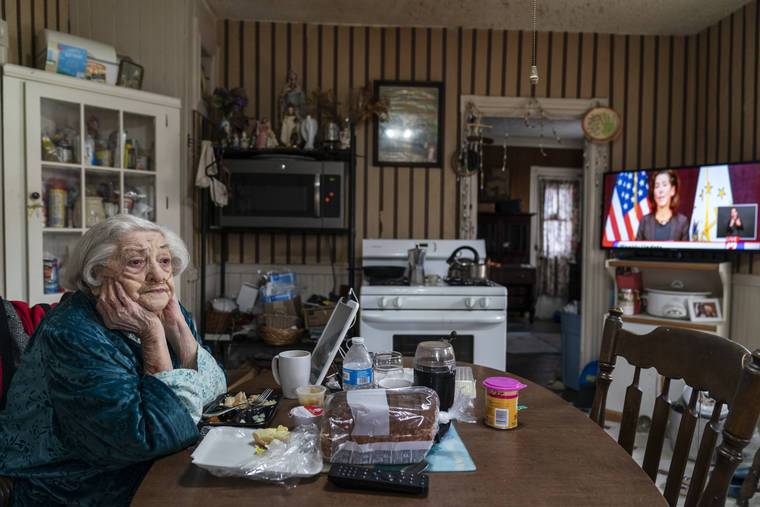PHOENIX — America is starting to claw its way out of the economic fallout from the coronavirus pandemic, but food insecurity persists, especially for children and older adults.
Food banks around the U.S. continue giving away far more canned, packaged and fresh provisions than they did before the virus outbreak tossed millions of people out of work, forcing many to seek something to eat for the first time. For those who are now back at work, many are still struggling, paying back rent or trying to rebuild savings.
“We have all been through an unimaginable year,” said Brian Greene, CEO of the Houston Food Bank, the network’s largest. It was distributing as much as 1 million pounds of groceries daily at various points during the pandemic last year.
Data from Feeding America, a national network of most food banks in the U.S., shows that its members dispensed far more in the last three months of 2020 – about 42% — compared with the same period in 2019.
Katie Fitzgerald, Feeding America’s chief operating officer, said she expects the food banks will collectively distribute the equivalent of 6 billion meals this year, about the same amount they gave away last year and far above the 4.2 billion meals given out in 2019.
“A lot of families who were living paycheck to paycheck before the pandemic were already experiencing food insecurity,” she said. “Now, the level of insecurity for some has grown more extreme, when you see real hunger — mom skipping meals to feed the family.”
The number of free meals districts served to children whose families meet income criteria fell sharply: Nationwide approximately 1.65 billion fewer breakfasts and lunches were served by child food service programs between March and November of 2020 than were served March through November of 2019 — a decrease of 30 percent.
From rural to urban areas, districts have had to get creative to deliver the food to kids.
In Phoenix on a recent, hazy afternoon, grownups and kids lined up by a yellow school bus for bags of free food.
The tiniest kids balanced multiple bags as they trudged home to apartments nearby, an occasional apple or juice box tumbling onto the asphalt. A young woman stuffed bags of food under her toddler’s stroller seat.
“This has been important because most refugees don’t have a ride,” said Sinthia Rehmet, originally from Pakistan. She was among those picking up bags containing small milk cartons, peanut butter, hamburgers and pre-cooked meals to be re-heated.
The Alhambra School District in Phoenix went from serving 6,000 free breakfasts and 9,600 free lunches every day before the pandemic down to about 2,500 meals overall daily.
As districts reopen, including some with hybrid models where kids don’t attend in person every day, schools are trying to ensure their access to food is consistent. The USDA has announced that during summer recess it will extend flexible food programs providing free meals to all children across the U.S. regardless of income.
Also struggling are older adults, many of whom have turned to food banks, Meals on Wheels home deliveries and other charities to get enough to eat.
Meals on Wheels America said at the end of 2020 its branches nationwide were still serving on average 60% more seniors than before COVID-19.
Over $1.675 billion in emergency funding has gone to nutrition programs under the Older Americans Act to pay for food, gas and drivers to deliver meals, along with masks, gloves and sanitizer to protect staff.
Jackie Robinson, a 66-year-old retired cook who once worked at a French Quarter restaurant in New Orleans, struggled to get by on his Social Security benefits before the pandemic. Over the summer he signed up for a city-run delivery program and now gets two meals a day, seven days a week.
“Things were getting kind of tough, a little rough and … I needed a little extra assistance,” he said.
The New Orleans program pays local restaurants to make food that is delivered to people who qualify. It feeds 11,200 people including about 4,000 seniors and is a partnership between the city and FEMA designed to get food to people at a time when they were being encouraged to stay home. It isn’t restricted to older adults, but officials had them in mind when they launched it last summer.
New Orleans resident Helen Smith Green, 76, uses a walker to get around and depended on her 96-year-old mother to cook for both of them before the older woman fell and went to an assisted living facility. Green now gets meals through the New Orleans program. Separately, she also gets a monthly food box delivered.
“I’m very thankful for these meals. It makes a big difference in your life, you know,” she said.
———
Santana reported from New Orleans and Choi reported from New York. AP writers Camille Fassett in Santa Cruz, California; Leah Willingham in Fayette, Mississippi and Cheyanne Mumphrey in Phoenix also contributed to this report.


